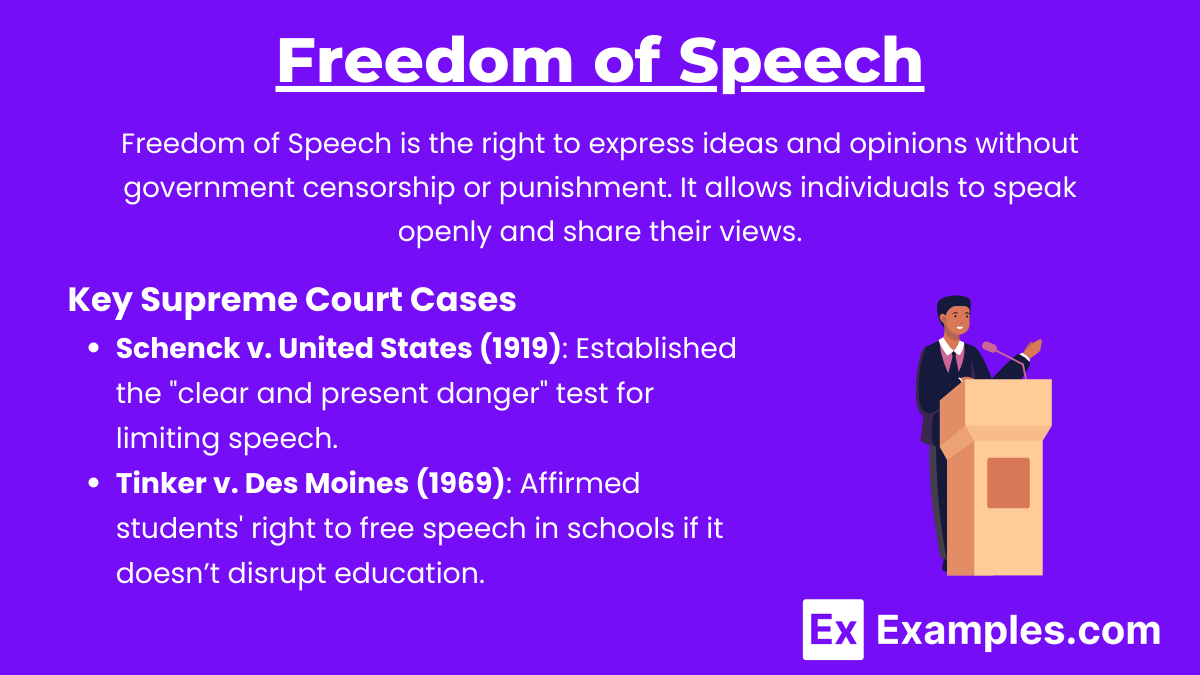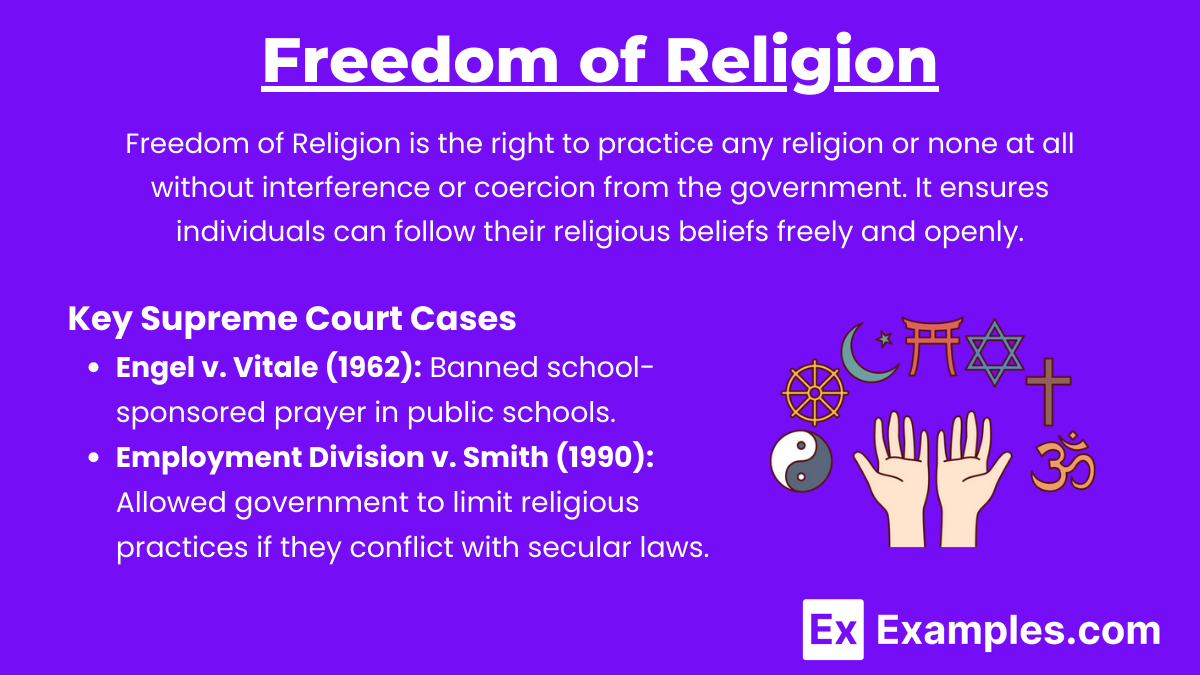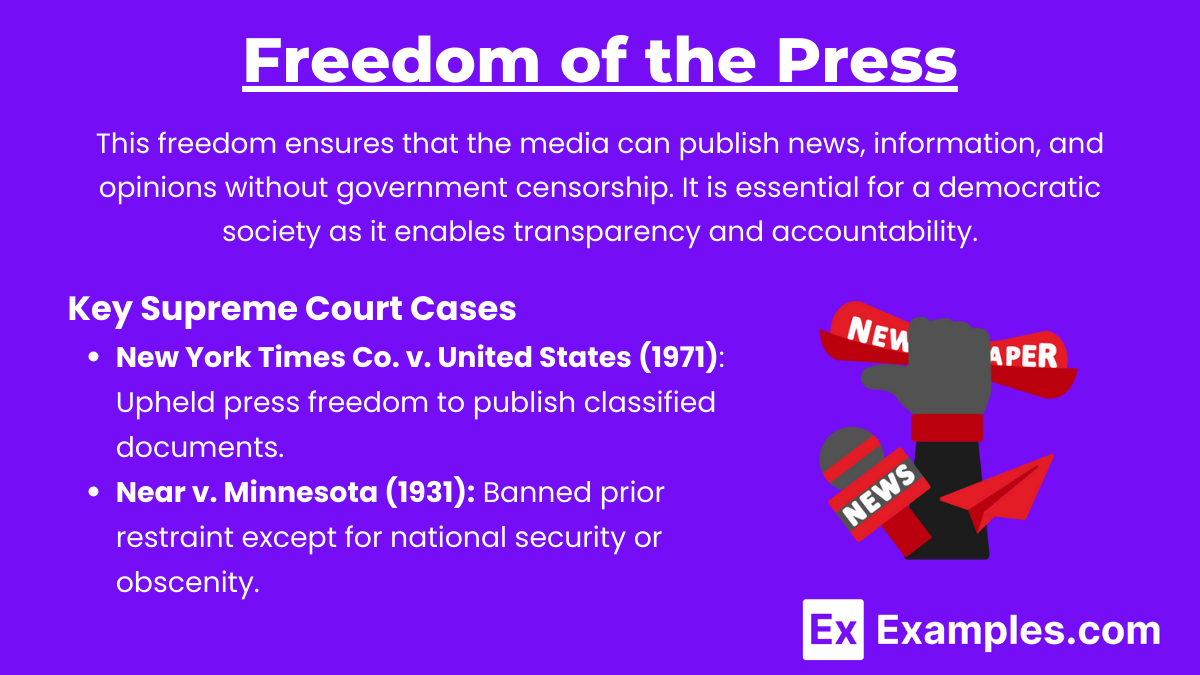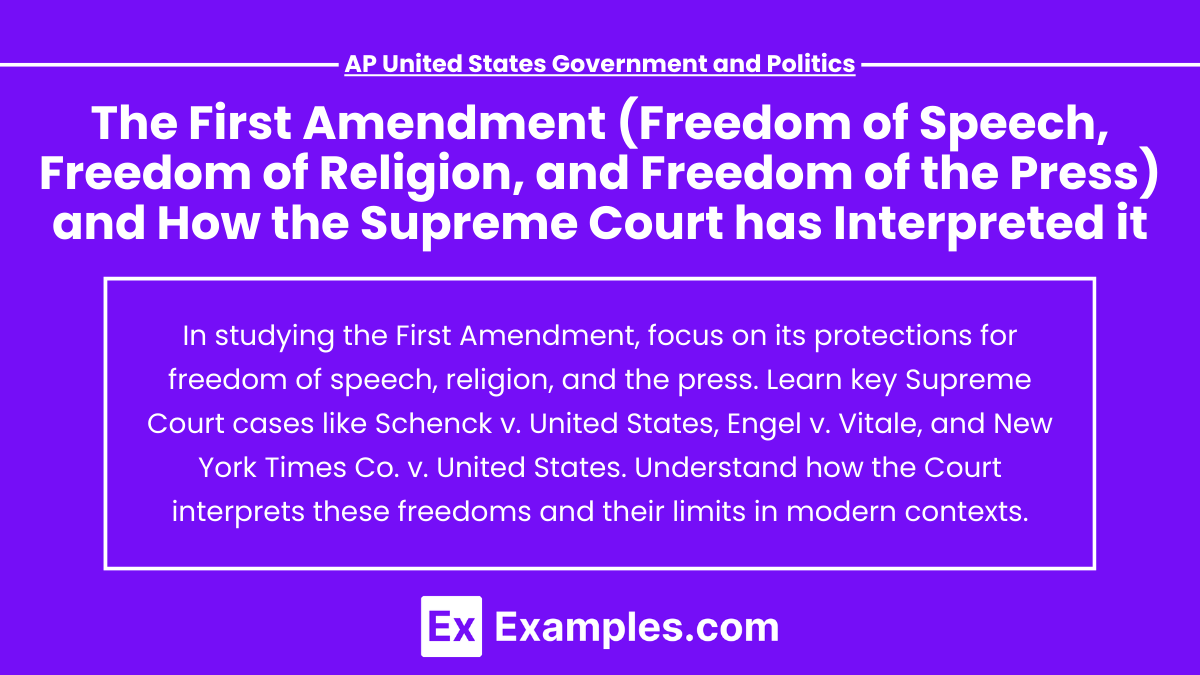The First Amendment protects fundamental freedoms essential to a democratic society, including freedom of speech, religion, and the press. These rights ensure individuals can express themselves, practice their beliefs, and access information without government interference. Over time, the Supreme Court has played a key role in interpreting these freedoms, balancing individual liberties with government interests. Key rulings have defined the limits of speech, religious expression, and press freedoms, shaping how the First Amendment is applied in modern society.
Free AP United States Government and Politics Practice Test
Learning Objectives
When studying "The First Amendment (Freedom of Speech, Freedom of Religion, and Freedom of the Press) and How the Supreme Court has Interpreted it" for the AP United States Government and Politics exam, focus on understanding the historical foundations and purpose of the First Amendment's protections. Learn the specific freedoms it guarantees, such as the right to express opinions, practice religion freely, and publish without government censorship. Study major Supreme Court cases that have shaped the interpretation of these rights, including limits on speech, religious freedom disputes, and the role of the press in democracy.
The First Amendment to the U.S. Constitution, ratified in 1791, is fundamental in protecting the core democratic values of free expression and religion. It guarantees three main freedoms:
Freedom of Speech
Freedom of Religion
Freedom of the Press
1. Freedom of Speech

The First Amendment's guarantee of freedom of speech allows individuals to express themselves without government interference. This includes both spoken and written forms of communication. The Supreme Court has interpreted this right to cover a broad range of expressions, including political speech, symbolic speech (like burning the flag), and even hate speech. However, not all speech is protected; exceptions include obscenity, defamation, and speech that incites violence.
Key Supreme Court Cases:
Schenck v. United States (1919): Established the "clear and present danger" test, which determines if speech poses a significant threat to national security or public safety.
Tinker v. Des Moines (1969): Affirmed that students retain their free speech rights in schools, as long as it does not disrupt the educational environment.
Citizens United v. Federal Election Commission (2010): Held that corporations and unions can spend unlimited amounts on political campaigns, citing free speech protections.
2. Freedom of Religion

Freedom of Religion is a fundamental right protected by the First Amendment, allowing individuals to practice any religion of their choice or to abstain from religion altogether without government interference. This freedom ensures that people can follow their spiritual beliefs and participate in religious practices openly, without fear of coercion or discrimination from the state.
Key Supreme Court Cases:
Engel v. Vitale (1962): Ruled that school-sponsored prayer in public schools violates the Establishment Clause.
Employment Division v. Smith (1990): Held that the government can limit religious practices if they conflict with valid, secular laws, as long as the law is not targeting a specific religion.
Burwell v. Hobby Lobby Stores, Inc. (2014): Allowed closely-held corporations to deny contraceptive coverage in health insurance based on religious objections.
3. Freedom of the Press

This freedom ensures that the media can publish news, information, and opinions without government censorship. It is essential for a democratic society as it enables transparency and accountability.
Key Supreme Court Cases:
New York Times Co. v. United States (1971): Affirmed the right of the press to publish classified documents (the Pentagon Papers) in the interest of public knowledge, emphasizing a strong presumption against prior restraint (censorship before publication).
Near v. Minnesota (1931): Established that prior restraint on publication is unconstitutional except in rare cases involving national security or obscenity.
Impact and Ongoing Issues
The Supreme Court's interpretations of the First Amendment have evolved to address contemporary issues, balancing individual rights with societal needs. Ongoing debates involve the limits of free speech in digital media, the extent of religious exemptions from laws, and the role of press freedom in a changing media landscape. Understanding these interpretations is crucial for grasping how the First Amendment continues to shape American democracy and individual liberties.
Examples
Example 1 : Freedom of Speech: Schenck v. United States (1919)
This landmark case established the "clear and present danger" test. Charles Schenck was convicted for distributing anti-draft pamphlets during World War I. The Court ruled that speech creating a clear and present danger, such as inciting resistance to lawful authority during wartime, could be restricted. This case marked a major limit on free speech, particularly in situations that threaten national security.
Example 2 : Freedom of Speech: Tinker v. Des Moines Independent Community School District (1969)
In this case, students wore black armbands to protest the Vietnam War and were suspended. The Supreme Court ruled that students do not lose their free speech rights at school, as long as the expression does not disrupt the learning environment. This case affirmed the right to symbolic speech and established the principle that students' rights to free speech are protected under the First Amendment.
Example 3 : Freedom of Religion: Engel v. Vitale (1962)
Engel v. Vitale dealt with a New York law that encouraged a non-denominational prayer to be recited in public schools. The Supreme Court ruled that this violated the Establishment Clause of the First Amendment, which prohibits government-sponsored religious activities. This decision reinforced the separation of church and state, particularly in public schools.
Example 4 : Freedom of Religion: Burwell v. Hobby Lobby Stores, Inc. (2014)
This case involved a closely-held corporation, Hobby Lobby, which objected to providing contraceptive coverage to employees as required by the Affordable Care Act, citing religious beliefs. The Supreme Court ruled that the Religious Freedom Restoration Act allowed corporations like Hobby Lobby to opt out of laws conflicting with their religious beliefs. This case expanded the Free Exercise Clause by extending religious rights to corporations.
Example 5 : Freedom of the Press: New York Times Co. v. United States (1971)
Known as the Pentagon Papers case, the government sought to prevent the New York Times from publishing classified documents regarding the Vietnam War. The Supreme Court ruled against prior restraint (censorship before publication), affirming that the government cannot block the press from publishing information unless there is a direct threat to national security. This case strengthened the protection of press freedom under the First Amendment.
Multiple Choice Questions
Question 1
Which of the following cases established the "clear and present danger" test for limiting freedom of speech?
A) Tinker v. Des Moines Independent Community School District
B) Schenck v. United States
C) New York Times Co. v. United States
D) Citizens United v. Federal Election Commission
Answer: B) Schenck v. United States
Explanation: In Schenck v. United States (1919), the Supreme Court ruled that speech could be restricted if it poses a "clear and present danger" to national security or public safety. This case involved anti-draft pamphlets during World War I, and the Court determined that in times of war, certain types of speech could be limited if they incite unlawful actions or present an immediate threat to national interests.
Question 2
In which case did the Supreme Court rule that school-sponsored prayer in public schools violates the Establishment Clause of the First Amendment?
A) Engel v. Vitale
B) Burwell v. Hobby Lobby Stores, Inc.
C) Tinker v. Des Moines Independent Community School District
D) Employment Division v. Smith
Answer: A) Engel v. Vitale
Explanation: In Engel v. Vitale (1962), the Supreme Court ruled that a New York law encouraging non-denominational prayer in public schools violated the Establishment Clause, which prohibits government involvement in religion. The Court held that even a voluntary, non-denominational prayer constitutes government endorsement of religion, which is forbidden under the First Amendment.
Question 3
Which case reinforced that the press cannot be subjected to prior restraint by the government, even in cases involving classified information?
A) Near v. Minnesota
B) New York Times Co. v. United States
C) Schenck v. United States
D) Citizens United v. Federal Election Commission
Answer: B) New York Times Co. v. United States
Explanation: In New York Times Co. v. United States (1971), the Supreme Court ruled against the government’s attempt to block the publication of the Pentagon Papers, asserting that prior restraint (censorship before publication) is unconstitutional. The Court held that the government must show direct and immediate harm to national security to justify restricting the press, which was not proven in this case. This decision reinforced the strong protections of freedom of the press under the First Amendment.


